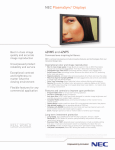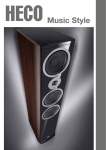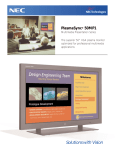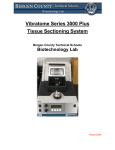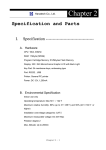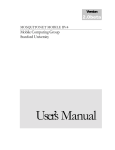Download Magnat Audio RX 22 Owner`s manual
Transcript
GB Dear MAGNAT Customer, The RX 44 car hi-fi power amplifier will enable you to satisfy your high demands on sound reproduction in your car. With its impressive deep-bass power reserves, low harmonic content and neutral reproduction, the RX 44 takes car hi-fi to new heights. The amplifier is characterized by low operating current, rapid switching capabilities and excellent temperature stability. Experience and enjoy how this high-tech machine perfectly reproduces magnificent sound. Please read all of the owner’s manual before installing and using the amplifier. 1. TECHNICAL DATA RX 44 Stereo Max. output power (1 kHz sinus burst 2:8, B+=14.4V) Nominal output power (DIN 45 342, B+=14.4V) Max. output power (1 kHz sinus burst 2:8, B+=14.4V) Nominal output power (DIN 45 342, B+=14.4V) Loudspeaker impedance (stereo) Frequency response Total harmonic content (DIN 45 403) Stereo separation (IEC 581 ) Weighted noise distance (IEC A) Input sensitivity LOW LEVEL INPUT Input impedance LOW LEVEL INPUT Low-pass filter High-pass filter Bass boost Subsonic filter Supply Fuse Sizes (W x H x D) Weight / Bridged 2 x 250 W / 1 x 650 W on 4 Ohm 2 x 125 W / 1 x 325 W on 4 Ohm 2 x 320 W on 2 Ohm 2 x 160 W on 2 Ohm 2 – 8 Ohm 5 – 50 000 Hz (-3 dB) < 0.05 % (1 kHz) > 60 dB (1 kHz) > 100 dB 0.4 – 4 V 20 kOhm 40 – 300 Hz, 12 dB per octave 40 – 300 Hz, 12 dB per octave 0…15 dB at 45 Hz 15 Hz, 12 dB per octave (channel 3 and 4 only) +12 V (9 – 15 V), minus to ground 2 x 40 A 350 x 50 x 261 mm 4.1 kg SUBJECT TO TECHNICAL CHANGE 2. FEATURES · · · · · · · · · · · · · · · · Complementary push-pull final stage Automatic switching on/off via car radio Infinitely adjustable low-pass filter 40 – 300 Hz Infinitely adjustable high-pass filter 40 – 300 Hz Infinitely variable bass equalisation Subsonic filter 15 Hz (channel 3 and 4 only) Adjustable input sensitivity Bridgeable 4-/3-/2-channel mode Tri-mode Channel mode selector switch Electronic protective circuit against short circuiting, DC offset and excess temperature Mute switch for suppressing switch-on crackle interference Capsulated loudspeaker and power-supply screw terminals Low-level outputs (cinch jacks) for connecting additional amplifiers (channel 3 and 4 only) Status indicator (green LED) and overload indicator (red LED) Harmonic distortion spectrum 9 GB 3. IMPORTANT INSTALLATION INFORMATION · · This appliance may only be connected to a 12 volt system with negative ground. The heat radiated when the amplifier is used means that sufficient air circulation is required at the place of installation. It is very important that the cooler’s cooler ribs do not contact any metal plating or any surfaces which could impair air circulation. The amplifier may not be installed in small confined spaces or spaces without air circulation (e.g. spare wheel recess or under the vehicle carpeting). Installation in the boot is recommended. Install the amplifier in such a way that it is protected as far as possible against vibrations and dust and dirt. Make sure that the input/output cables are sufficiently distant from the power supply cables as otherwise interference may occur. Make sure that the fuse and operating elements are accessible after installation. The appliance’s reliability and performance depend on the quality of installation. Preferably get an expert to install the system, particularly if you want to install several loudspeakers or a complex multi-way system. · · · · 4. CONNECTIONS 4.1 POWER SUPPLY AND AUTOMATIC SWITCHING ON Important notice: Before commencing the installation, disconnect the plus terminals from the car battery in order to prevent short circuits. The power cabling usually installed in on-board car networks is not sufficient for a power amplifier’s demands. Make sure that the power lines to GND and to the +12 V terminal have been sufficiently specified. A cable crosssection of at least 16 mm² must be used to connect the battery to the amplifier’s terminals. First connect the amplifier’s GND terminal to the battery’s minus pole. It is very important that the connection is good. Dirt residues must be carefully removed from the battery’s connection point. A loose connection may cause malfunctions or interference noise or distortion. The +12 V amplifier connection must then be connected with a power cable possessing an integrated fuse to the battery’s plus pole. The fuse must be located close to the battery, the length of cable from the battery’s positive pole to the fuse must be less than 60 centimetres for safety reasons. Only insert the fuse when all installation work, including the connection of the loudspeakers, has been completed. Now connect the car hi-fi receiver’s remote control connection to the amplifier’s REM control jack. A cable with a cross-section of 0.75 mm² is sufficient for connecting the amplifier’s REMOTE connection and the control device. 4.2 AUDIO CABLES When installing the audio cable between the cinch output of your car receiver and the cinch input of the amplifier inside your car, the audio and power supply cables should, wherever possible, not be routed along the same side of the vehicle. We recommend an isolated installation, e.g. routing the power cable through the cable duct on the left-hand side and the audio cable through the cable duct on the right-hand side or vice versa. This reduces interference due to crosstalk into the audio cables. 4.3 LOUDSPEAKER CONNECTIONS · · · · · In normal operating mode (i.e. one loudspeaker on each individual amplifier channel), the lowest terminal resistance is 2 ohm per channel. In bridging mode (two amplifier outputs combined) the lowest terminal resistance doubles to 4 ohm. The impedance in tri-mode may not fall below 2 ohm per channel. Never connect the loudspeakers’ minus terminals to the vehicle chassis. Never connect the +12 V supply voltage to a loudspeaker output as this would destroy the amplifier final stage. If the amplifier is operated with lower terminal resistances or incorrectly used as described above, both the amplifier and the loudspeakers may be damaged. The warranty becomes void in such cases. 10 GB 5. OPERATING ELEMENTS AND IN/OUTPUTS 5.1 SETTING THE INPUT SENSITIVITY The input sensitivity may be adapted to any car radio or tape deck. Turn the volume control of your radio to its central position and then adjust the input-level controls (12) and (13) to produce an average medium volume. This setting usually provides sufficient power reserves at optimum weighted noise voltage. ATTENTION: only reproduce loud test noises briefly to prevent damaging the loudspeakers. 5.2 LOW-PASS FILTER WITH ADJUSTABLE CROSS-OVER FREQUENCY If the amplifier is used as a subwoofer amplifier, set the switch (2)/(3) to “LOW”. Set the desired cross-over frequency using the control (4)/(5). This makes the filter adaptable to the installed woofer’s sound requirements. The filter’s high edge steepness is responsible for the precision reduction of medium and high frequency ranges. 5.3 HIGH-PASS FILTER WITH ADJUSTABLE CROSS-OVER FREQUENCY If the amplifier is to be used as an amplifier for satellite loudspeakers (mid-range/tweeter loudspeakers), set switch (2)/(3) to “HIGH”. Set the desired cross-over frequency using the control (6)/(7). Only the frequencies above the set cross-over frequency will then be amplified. This effectively minimizes distortions caused by excessive membrane movement at low frequencies and small satellite loudspeakers without reducing the bass level. 5.4 BASS-BOOST The bass-boost function (10/11) is used to increase or equalize the lower bass frequencies. 5.5 SUBSONIC FILTER (CHANNEL 3 AND 4 ONLY) The subsonic filter (8) attenuates the lowest bass frequencies. This arrangement allows efficient prevention of distortion caused by excessive membrane excursions without affecting the useable bass level. 5.6 OUTPUTS FOR CONNECTING ADDITIONAL AMPLIFIERS The input signal of the INPUT connections CH3 / CH4 (14) is forwarded directly to the OUTPUT (1) jacks. The OUTPUT connections allow the use of additional amplifiers without requiring additional T-plugs and cables. FIG. 1 POWER SUPPLY / REMOTE SWITCH-ON CONNECTIONS (1) (2) (3) (4) (5) (6) Terminal for +12 V battery voltage REM terminal for remote switch-on GND terminal for the ground, to the battery’s minus pole Battery Cable fuse To your car radio’s automatic aerial connection If your car is not equipped with an automatic aerial connection, connect this cable’s plus pole (+) to the ignition lock. An on/off switch should be inserted in this case. Make sure that this switch is switched off if the amplifier is not used. 11 GB FIG. 2 4-CHANNEL MODE Connect and set the amplifier as shown in Fig. 2 if it is to be controlled by a car radio with four output channels and used with four loudspeakers: (1) (2) (3) (4) (5) (6) (7) (8) To the car radio, front left output To the car radio, front right output To the car radio, rear left output To the car radio, rear right output Front left loudspeaker Front right loudspeaker Rear left loudspeaker Rear right loudspeaker FIG. 3/4 3-CHANNEL MODE The 3-channel mode uses the high-pass filter for channels 1/2 and the low-pass filter for Channels 3/4. Section 5 describes how they are used. FIG. 3 Connect and set the amplifier as shown in Fig. 3 if it is to be controlled by a car radio with stereo output and used with stereo satellite loudspeakers and a subwoofer. (1) (2) (3) (4) (5) To the car radio, left output To the car radio, right output Left satellite loudspeaker Right satellite loudspeaker Subwoofer FIG. 4 Connect and set the amplifier as shown in Fig. 4 if it is to be controlled by a car radio with stereo receiver and separate subwoofer output and used with stereo satellite loudspeakers and a subwoofer. (1) (2) (3) (4) (5) (6) To the car radio, left output To the car radio, right output To the car radio, subwoofer output Left satellite loudspeaker Right satellite loudspeaker Subwoofer FIG. 5 2-CHANNEL MODE If the amplifier has to generate more power to operate two subwoofers, connect and set it as shown in Fig. 5. The use of the low-pass filter used is described in Chapter 5. (1) (2) (3) (4) To the car radio, left output To the car radio, right output Subwoofer Subwoofer 12 GB FIG. 6 (1) (2) (3) (4) (5) (6) (7) (8) (9) To the car radio, front left output To the car radio, front right output To the car radio, rear left output To the car radio, rear right output Front left loudspeaker Front right loudspeaker Rear left loudspeaker Rear right loudspeaker Subwoofer FIG. 7 (1) (2) (3) (4) (5) (6) (7) (8) (9) (10) (11) (12) (13) (14) (15) USE AS AN AMPLIFIER FOR FOUR SATELLITE LOUDSPEAKERS AND A SUBWOOFER USING AN ADDITIONAL 2-CHANNEL AMPLIFIER (RX 22) OPERATING ELEMENTS AND IN/OUTPUTS Low level outputs (channel 3/4) HPF (high-pass filter) / LPF (low-pass filter) / OFF option switch for channel 3/4 HPF (high-pass filter) / LPF (low-pass filter) / OFF option switch for channel 1/2 Cross-over frequency control for the low pass (channel 3/4) Cross-over frequency control for the low pass (channel 1/2) Cross-over frequency control for the high pass (channel 3/4) Cross-over frequency control for the high pass (channel 1/2) Switch for the subsonic filter Channel mode selector switch Bass-boost control (channel 3/4, rear) Bass-boost control (channel 1/2, front) Input-level control channel 3/4 Input-level control channel 1/2 Low-level inputs (channel 3/4, rear) Low-level inputs (channel 1/2, front) 13 58 3 59 60 61 6 62 7 63











